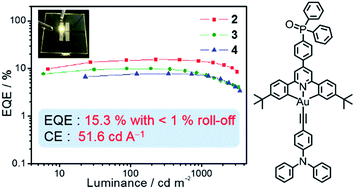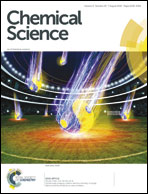Highly luminescent phosphine oxide-containing bipolar alkynylgold(iii) complexes for solution-processable organic light-emitting devices with small efficiency roll-offs†
Abstract
We report the synthesis of alkynylgold(III) complexes with an electron-transporting phosphine oxide moiety in the tridentate ligand and hole-transporting triarylamine moieties as auxiliary ligands to generate a new class of phosphine oxide-containing bipolar gold(III) complexes for the first time. Such gold(III) complexes feature high photoluminescence quantum yields of over 70% in 1,3-bis(N-carbazolyl)benzene thin films with relatively short excited-state lifetimes of less than 3.9 μs at a 20 wt% dopant concentration. Highly efficient solution-processable organic light-emitting devices have been prepared with superior current efficiencies of up to 51.6 cd A−1 and external quantum efficiencies of up to 15.3%. Notably, triplet–triplet annihilation has been significantly reduced, as exemplified by a very small efficiency roll-off of ∼1% at a practical brightness of 500 cd m−2.

- This article is part of the themed collections: 2018 Chemical Science HOT Article Collection and Collection to celebrate our diverse and global authorship


 Please wait while we load your content...
Please wait while we load your content...